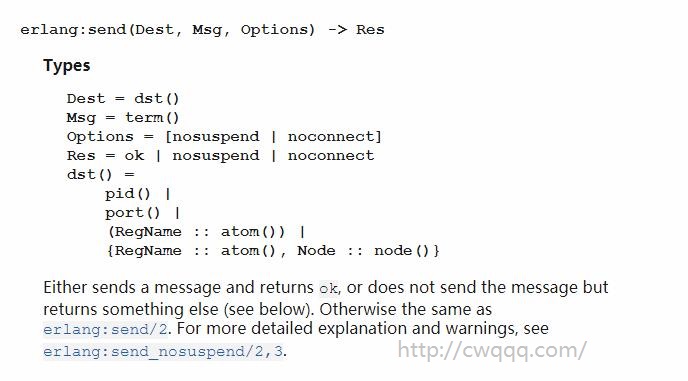原文 2015-01-24 01:07:54 发表于 CSDN,这里对以前写的文章做下收录。
erlang send是一个很基础的消息发送函数,用于进程把一个消息发给另外一个进程。这个函数可以同时用于本地节点进程通信,或者和远程节点进程之间的通信。
最近有同事遇到erlang:send导致消息堆积问题,这个引起了我的强烈关注。我也看了这块的代码,这里简单做个分享。
函数原型:
erlang:send(Dest, Msg, Options) -> Res

Options可以是以下2个:
nosuspend
If the sender would have to be suspended to do the send, nosuspend is returned instead.
noconnect
If the destination node would have to be auto-connected before doing the send, noconnect is returned instead.
字面上意思是说:
nosuspend 遇到会挂起进程的场合不挂起进程,直接返回nosuspend
noconnect 遇到远程节点没有连接时不会自动连接发送消息,直接返回noconnect
但是,erlang直接在文档说慎用nosuspend Warning
As with erlang:send_nosuspend/2,3: Use with extreme care!
到底为什么这么说,而且返回nosuspend 时这个消息是发送出去了,还是没发送出去?
源码剖析
看了erlang代码,erlang:send是bif实现的,这里以R16B02做说明:
/**
* bif.c send_3()函数,实现erlang:send/3
*/
BIF_RETTYPE send_3(BIF_ALIST_3)
{
Eterm ref;
Process *p = BIF_P;
Eterm to = BIF_ARG_1;
Eterm msg = BIF_ARG_2;
Eterm opts = BIF_ARG_3;
int connect = !0; // 初始值设1,表示非0值
int suspend = !0; // 同上
Eterm l = opts;
Sint result;
while (is_list(l)) { //遍历参数列表
if (CAR(list_val(l)) == am_noconnect) {
connect = 0; // 参数带 noconnect,则 connect 取值0
} else if (CAR(list_val(l)) == am_nosuspend) {
suspend = 0; // 同上
} else {
BIF_ERROR(p, BADARG);
}
l = CDR(list_val(l));
}
if(!is_nil(l)) {
BIF_ERROR(p, BADARG);
}
// 调用 do_send 发送消息;result 大于0表示本次消息发送要扣除的reds,其他则表示错误码
result = do_send(p, to, msg, suspend, &ref);
if (result > 0) {
ERTS_VBUMP_REDS(p, result); // 扣除本次消息发送的 reds
if (ERTS_IS_PROC_OUT_OF_REDS(p))
goto yield_return;
BIF_RET(am_ok);
}
switch (result) {
case 0:
/* May need to yield even though we do not bump reds here... */
if (ERTS_IS_PROC_OUT_OF_REDS(p))
goto yield_return;
BIF_RET(am_ok);
break;
// 遇到 SEND_TRAP 错误
case SEND_TRAP:
if (connect) {
// connect 不等于 0
BIF_TRAP3(dsend3_trap, p, to, msg, opts);
} else {
// connect 等于 0,直接返回 noconnect
BIF_RET(am_noconnect);
}
break;
// 遇到 SEND_YIELD 错误
case SEND_YIELD:
if (suspend) {
// suspend 不等于 0
ERTS_BIF_YIELD3(bif_export[BIF_send_3], p, to, msg, opts);
} else {
// suspend 等于 0,直接返回 nosuspend
BIF_RET(am_nosuspend);
}
break;
// 遇到 SEND_YIELD_RETURN 错误
case SEND_YIELD_RETURN:
// suspend 等于 0,直接返回 nosuspend
if (!suspend)
BIF_RET(am_nosuspend);
yield_return:
ERTS_BIF_YIELD_RETURN(p, am_ok);
case SEND_AWAIT_RESULT:
ASSERT(is_internal_ref(ref));
BIF_TRAP3(await_port_send_result_trap, p, ref, am_nosuspend, am_ok);
case SEND_BADARG:
BIF_ERROR(p, BADARG);
break;
case SEND_USER_ERROR:
BIF_ERROR(p, EXC_ERROR);
break;
case SEND_INTERNAL_ERROR:
BIF_ERROR(p, EXC_INTERNAL_ERROR);
break;
default:
ASSERT(! "Illegal send result");
break;
}
ASSERT(! "Can not arrive here");
BIF_ERROR(p, BADARG);
}
再来看看 do_send() 函数:
/*
* bif.c do_send()函数,实现发送到其他进程,或端口,或远程进程
* 返回消息发送的reds,或错误码
*/
//以下几个是 do_send 可能返回的错误码
#define SEND_TRAP (-1)
#define SEND_YIELD (-2)
#define SEND_YIELD_RETURN (-3)
#define SEND_BADARG (-4)
#define SEND_USER_ERROR (-5)
#define SEND_INTERNAL_ERROR (-6)
#define SEND_AWAIT_RESULT (-7)
Sint
do_send(Process *p, Eterm to, Eterm msg, int suspend, Eterm *refp) {
Eterm portid;
Port *pt;
Process* rp;
DistEntry *dep;
Eterm* tp;
// 如果目标进程在本地节点
if (is_internal_pid(to)) {
if (IS_TRACED(p))
trace_send(p, to, msg);
if (ERTS_PROC_GET_SAVED_CALLS_BUF(p))
save_calls(p, &exp_send);
rp = erts_proc_lookup_raw(to);
if (!rp)
return 0;
// 找到这个进程则执行最后的 send_message
} else if (is_external_pid(to)) {
// 如果目标进程在远程节点
dep = external_pid_dist_entry(to);
if(dep == erts_this_dist_entry) {
erts_dsprintf_buf_t *dsbufp = erts_create_logger_dsbuf();
erts_dsprintf(dsbufp,
"Discarding message %T from %T to %T in an old "
"incarnation (%d) of this node (%d)\n",
msg,
p->common.id,
to,
external_pid_creation(to),
erts_this_node->creation);
erts_send_error_to_logger(p->group_leader, dsbufp);
return 0;
}
// 远程消息调用 remote_send 发送
return remote_send(p, dep, to, to, msg, suspend);
} else if (is_atom(to)) {
// 如果传参是原子,尝试从进程表找到这个进程
Eterm id = erts_whereis_name_to_id(p, to);
rp = erts_proc_lookup(id);
if (rp)
goto send_message;
// 找不到这个进程,检查目标是不是端口
pt = erts_port_lookup(id, ERTS_PORT_SFLGS_INVALID_LOOKUP);
if (pt) {
portid = id;
goto port_common;
}
if (IS_TRACED(p))
trace_send(p, to, msg);
if (ERTS_PROC_GET_SAVED_CALLS_BUF(p))
save_calls(p, &exp_send);
return SEND_BADARG;
} else if (is_external_port(to)
&& (external_port_dist_entry(to)
== erts_this_dist_entry)) {
erts_dsprintf_buf_t *dsbufp = erts_create_logger_dsbuf();
erts_dsprintf(dsbufp,
"Discarding message %T from %T to %T in an old "
"incarnation (%d) of this node (%d)\n",
msg,
p->common.id,
to,
external_port_creation(to),
erts_this_node->creation);
erts_send_error_to_logger(p->group_leader, dsbufp);
return 0;
} else if (is_internal_port(to)) {
// 如果是本地端口
int ret_val;
portid = to;
pt = erts_port_lookup(portid, ERTS_PORT_SFLGS_INVALID_LOOKUP);
port_common:
ret_val = 0;
if (pt) {
int ps_flags = suspend ? 0 : ERTS_PORT_SIG_FLG_NOSUSPEND;
*refp = NIL;
// 执行端口操作
switch (erts_port_command(p, ps_flags, pt, msg, refp)) {
case ERTS_PORT_OP_CALLER_EXIT:
/* We are exiting... */
return SEND_USER_ERROR;
case ERTS_PORT_OP_BUSY:
/* Nothing has been sent */
if (suspend)
erts_suspend(p, ERTS_PROC_LOCK_MAIN, pt);
// 如果 nosuspend 返回 SEND_YIELD,消息还没发送
return SEND_YIELD;
case ERTS_PORT_OP_BUSY_SCHEDULED:
/* Message was sent */
if (suspend) {
erts_suspend(p, ERTS_PROC_LOCK_MAIN, pt);
ret_val = SEND_YIELD_RETURN;
break;
}
// 这里没有break,如果 nosuspend 将执行下一步操作,消息已发送
/* Fall through */
case ERTS_PORT_OP_SCHEDULED:
if (is_not_nil(*refp)) {
ASSERT(is_internal_ref(*refp));
ret_val = SEND_AWAIT_RESULT;
}
break;
case ERTS_PORT_OP_DROPPED:
case ERTS_PORT_OP_BADARG:
case ERTS_PORT_OP_DONE:
break;
default:
ERTS_INTERNAL_ERROR("Unexpected erts_port_command() result");
break;
}
}
if (IS_TRACED(p)) /* trace once only !! */
trace_send(p, portid, msg);
if (ERTS_PROC_GET_SAVED_CALLS_BUF(p))
save_calls(p, &exp_send);
if (SEQ_TRACE_TOKEN(p) != NIL
#ifdef USE_VM_PROBES
&& SEQ_TRACE_TOKEN(p) != am_have_dt_utag
#endif
) {
seq_trace_update_send(p);
seq_trace_output(SEQ_TRACE_TOKEN(p), msg,
SEQ_TRACE_SEND, portid, p);
}
if (ERTS_PROC_IS_EXITING(p)) {
KILL_CATCHES(p); /* Must exit */
return SEND_USER_ERROR;
}
return ret_val;
} else if (is_tuple(to)) { /* Remote send */
// 如果to是原子,走到这里只有是发送远程消息的情况了
int ret;
tp = tuple_val(to);
if (*tp != make_arityval(2))
return SEND_BADARG;
if (is_not_atom(tp[1]) || is_not_atom(tp[2]))
return SEND_BADARG;
/* sysname_to_connected_dist_entry will return NULL if there
is no dist_entry or the dist_entry has no port,
but remote_send() will handle that. */
// 找到 dist_entry 就用本地进程消息或端口形式发送
dep = erts_sysname_to_connected_dist_entry(tp[2]);
if (dep == erts_this_dist_entry) {
Eterm id;
erts_deref_dist_entry(dep);
if (IS_TRACED(p))
trace_send(p, to, msg);
if (ERTS_PROC_GET_SAVED_CALLS_BUF(p))
save_calls(p, &exp_send);
id = erts_whereis_name_to_id(p, tp[1]);
rp = erts_proc_lookup_raw(id);
if (rp)
goto send_message;
pt = erts_port_lookup(id, ERTS_PORT_SFLGS_INVALID_LOOKUP);
if (pt) {
portid = id;
goto port_common;
}
return 0;
}
// 找不到 dist_entry 就用 remote_send 发送
ret = remote_send(p, dep, tp[1], to, msg, suspend);
if (dep)
erts_deref_dist_entry(dep);
return ret;
} else {
if (IS_TRACED(p)) /* XXX Is this really neccessary ??? */
trace_send(p, to, msg);
if (ERTS_PROC_GET_SAVED_CALLS_BUF(p))
save_calls(p, &exp_send);
return SEND_BADARG;
}
// 以下过程是处理本节点进程消息
send_message: {
ErtsProcLocks rp_locks = 0;
Sint res;
#ifdef ERTS_SMP
if (p == rp)
rp_locks |= ERTS_PROC_LOCK_MAIN;
#endif
/* send to local process */
res = erts_send_message(p, rp, &rp_locks, msg, 0);
if (erts_use_sender_punish)
res *= 4;
else
res = 0;
erts_smp_proc_unlock(rp,
p == rp
? (rp_locks & ~ERTS_PROC_LOCK_MAIN)
: rp_locks);
return res;
}
}
再看下本地进程消息处理 erts_send_message() 函数:
/*
* erl_message.c erts_send_message()函数 实现发送本地消息给进程
*/
Sint
erts_send_message(Process* sender,
Process* receiver,
ErtsProcLocks *receiver_locks,
Eterm message,
unsigned flags)
{
Uint msize;
ErlHeapFragment* bp = NULL;
Eterm token = NIL;
Sint res = 0;
#ifdef USE_VM_PROBES
DTRACE_CHARBUF(sender_name, 64);
DTRACE_CHARBUF(receiver_name, 64);
Sint tok_label = 0;
Sint tok_lastcnt = 0;
Sint tok_serial = 0;
#endif
BM_STOP_TIMER(system);
BM_MESSAGE(message,sender,receiver);
BM_START_TIMER(send);
#ifdef USE_VM_PROBES
*sender_name = *receiver_name = '\0';
if (DTRACE_ENABLED(message_send)) {
erts_snprintf(sender_name, sizeof(DTRACE_CHARBUF_NAME(sender_name)),
"%T", sender->common.id);
erts_snprintf(receiver_name, sizeof(DTRACE_CHARBUF_NAME(receiver_name)),
"%T", receiver->common.id);
}
#endif
if (SEQ_TRACE_TOKEN(sender) != NIL && !(flags & ERTS_SND_FLG_NO_SEQ_TRACE)) {
// 发送进程打了跟踪标记 sequential_trace_token;后面处理进程跟踪过程
// 见 http://www.erlang.org/doc/man/erlang.html#process_flag-3
/*
* 篇幅有限,这里省略了部分无关代码
*/
} else if (sender == receiver) {
// 进程发送消息给自己
/* 如果进程正在关闭,则丢弃消息 */
#ifdef ERTS_SMP
ErtsProcLocks need_locks = (~(*receiver_locks)
& (ERTS_PROC_LOCK_MSGQ
| ERTS_PROC_LOCK_STATUS));
if (need_locks) {
*receiver_locks |= need_locks;
if (erts_smp_proc_trylock(receiver, need_locks) == EBUSY) {
if (need_locks == ERTS_PROC_LOCK_MSGQ) {
erts_smp_proc_unlock(receiver, ERTS_PROC_LOCK_STATUS);
need_locks = ERTS_PROC_LOCK_MSGQ|ERTS_PROC_LOCK_STATUS;
}
erts_smp_proc_lock(receiver, need_locks);
}
}
if (!ERTS_PROC_PENDING_EXIT(receiver))
#endif
{
ErlMessage* mp = message_alloc();
DTRACE6(message_send, sender_name, receiver_name,
size_object(message), tok_label, tok_lastcnt, tok_serial);
mp->data.attached = NULL;
ERL_MESSAGE_TERM(mp) = message;
ERL_MESSAGE_TOKEN(mp) = NIL;
#ifdef USE_VM_PROBES
ERL_MESSAGE_DT_UTAG(mp) = NIL;
#endif
mp->next = NULL;
// SMP下把消息移到进程私有堆尾部(纯指针操作)
ERTS_SMP_MSGQ_MV_INQ2PRIVQ(receiver);
// 把消息追加到消息队列尾部(纯指针操作)
LINK_MESSAGE_PRIVQ(receiver, mp);
// res 取进程消息队列长度
res = receiver->msg.len;
if (IS_TRACED_FL(receiver, F_TRACE_RECEIVE)) {
trace_receive(receiver, message);
}
}
BM_SWAP_TIMER(send,system);
} else {
// 进程发送消息给别的进程
#ifdef ERTS_SMP
ErlOffHeap *ohp;
Eterm *hp;
erts_aint32_t state;
BM_SWAP_TIMER(send,size);
msize = size_object(message);
BM_SWAP_TIMER(size,send);
// 接收者进程分配一个大小为 msize 的堆空间,用于存放这个消息
hp = erts_alloc_message_heap_state(msize,
&bp,
&ohp,
receiver,
receiver_locks,
&state);
BM_SWAP_TIMER(send,copy);
// 复制消息到接受者进程,返回值 message 有可能是引用二进制 refc binary
message = copy_struct(message, msize, &hp, ohp);
BM_MESSAGE_COPIED(msz);
BM_SWAP_TIMER(copy,send);
DTRACE6(message_send, sender_name, receiver_name,
msize, tok_label, tok_lastcnt, tok_serial);
// res 取接收者进程消息队列长度
res = queue_message(sender,
receiver,
receiver_locks,
&state,
bp,
message,
token
#ifdef USE_VM_PROBES
, NIL
#endif
);
BM_SWAP_TIMER(send,system);
#else
ErlMessage* mp = message_alloc();
Eterm *hp;
BM_SWAP_TIMER(send,size);
msize = size_object(message);
BM_SWAP_TIMER(size,send);
// 检查接收者进程内存不足,执行GC
if (receiver->stop - receiver->htop <= msize) { BM_SWAP_TIMER(send,system); erts_garbage_collect(receiver, msize, receiver->arg_reg, receiver->arity);
BM_SWAP_TIMER(system,send);
}
hp = receiver->htop;
receiver->htop = hp + msize;
BM_SWAP_TIMER(send,copy);
// 处理引用二进制的数据(修改引用计数)
message = copy_struct(message, msize, &hp, &receiver->off_heap);
BM_MESSAGE_COPIED(msize);
BM_SWAP_TIMER(copy,send);
DTRACE6(message_send, sender_name, receiver_name,
(uint32_t)msize, tok_label, tok_lastcnt, tok_serial);
ERL_MESSAGE_TERM(mp) = message;
ERL_MESSAGE_TOKEN(mp) = NIL;
#ifdef USE_VM_PROBES
ERL_MESSAGE_DT_UTAG(mp) = NIL;
#endif
mp->next = NULL;
mp->data.attached = NULL;
LINK_MESSAGE(receiver, mp);
// res 取接收者进程消息队列长度
res = receiver->msg.len;
/* 将接收者进程添加到调度队列
* 接收者进程可能receive消息导致失去调度,在新消息到来时需要将进程加到调度队列。
*/
erts_proc_notify_new_message(receiver);
if (IS_TRACED_FL(receiver, F_TRACE_RECEIVE)) {
trace_receive(receiver, message);
}
BM_SWAP_TIMER(send,system);
#endif /* #ifndef ERTS_SMP */
}
return res;
}
再来看看 remote_send() 函数:
/**
* bif.c remote_send()函数,实现远程消息发送
* dist_entry是erlang分布式接口
*/
static Sint remote_send(Process *p, DistEntry *dep,
Eterm to, Eterm full_to, Eterm msg, int suspend)
{
Sint res;
int code;
ErtsDSigData dsd;
ASSERT(is_atom(to) || is_external_pid(to));
//检查dist_entry状态
code = erts_dsig_prepare(&dsd, dep, p, ERTS_DSP_NO_LOCK, !suspend);
switch (code) {
case ERTS_DSIG_PREP_NOT_ALIVE:
case ERTS_DSIG_PREP_NOT_CONNECTED: // 连接不存在直接返回 SEND_TRAP
res = SEND_TRAP;
break;
// suspend 走这里,返回 SEND_YIELD
case ERTS_DSIG_PREP_WOULD_SUSPEND:
ASSERT(!suspend);
res = SEND_YIELD;
break;
// nosuspend 在dist_entry连接非稳定状态时会走这里,强制把消息压入发送队列,返回 0,即发送完成
case ERTS_DSIG_PREP_CONNECTED: {
if (is_atom(to))
code = erts_dsig_send_reg_msg(&dsd, to, msg);
else
code = erts_dsig_send_msg(&dsd, to, msg);
/*
* Note that reductions have been bumped on calling
* process by erts_dsig_send_reg_msg() or
* erts_dsig_send_msg().
*/
if (code == ERTS_DSIG_SEND_YIELD)
res = SEND_YIELD_RETURN;
else
res = 0;
break;
}
default:
ASSERT(! "Invalid dsig prepare result");
res = SEND_INTERNAL_ERROR;
}
if (res >= 0) {
if (IS_TRACED(p))
trace_send(p, full_to, msg);
if (ERTS_PROC_GET_SAVED_CALLS_BUF(p))
save_calls(p, &exp_send);
}
return res;
}
其中,erts_dsig_send_msg() 底层调用了 dsig_send,把消息放到发送队列,再由 port_task 工作线程负责把消息投递到其他节点。这里面篇幅较大,主要是dist.c, erl_port_task.c, erl_process.c, erl_node_tables.c, io.c 这几个模块,以后找时间再讲。
问题讨论
1、erlang:send 不带 nosuspend / noconnect, 会导致消息堆积?
erlang被挂起时(也就是进程是{status,suspended}),就会导致当前这个进程消息堆积。
30> Pid = spawn(fun() -> receive M -> M end end).
<0.68.0>
31> process_info(Pid,messages).
{messages,[]}
32> erlang:suspend_process(Pid).
true
33> Pid ! hello.
hello
34> process_info(Pid,status).
{status,suspended}
35> process_info(Pid,messages).
{messages,[hello]}
2、为什么erlang文档说慎用 nosuspend ?
因为,当消息无法发送时,原本会导致发送者进程失去调度权,但是这种方法则会以返回值的方式通知调用者端口忙,不会抑制发送者进程。特别是在分布式环境下,当erlang:send 使用了nosuspend时,当端口繁忙堆积了很多消息时,还会强制把消息压入端口发送队列,如果端口一直处于不稳定的状态,就会导致消息不停的堆积,撑爆内存。所以,还是建议使用 noconnect,当连接异常时就会返回 noconnect ,程序这边再做异常处理
3、erlang:send 返回nosuspend 时这个消息是发送出去了,还是没发送出去?
当返回nosuspend 时这个消息肯定是没发送出去。(文章这里最开始写错了,所以网上搜到这篇文章都是错的,建议还是少上那些复制网站)
扩展延伸
reductions
可以理解为 Erlang的基本调度计量单位,Erlang VM基于reduction来进行调度,用来保证调度实现的准实时性。进程的 reduction 值越高,得到的调度机会就越多。
trap_send
前面代码提到了SEND_TRAP 错误,也就是这里
case SEND_TRAP:
if (connect) {
BIF_TRAP3(dsend3_trap, p, to, msg, opts);
} else {
BIF_RET(am_noconnect);
}
break;
看下BIF_TRAP3的代码,实际是个宏,修改当前进程的'寄存器'信息,关键是设置 freason 为 TRAP
#define BIF_TRAP3(Trap_, p, A0, A1, A2) do { \
Eterm* reg = ERTS_PROC_GET_SCHDATA((p))->x_reg_array; \
(p)->arity = 3; \
reg[0] = (A0); \
reg[1] = (A1); \
reg[2] = (A2); \
(p)->i = (BeamInstr*) ((Trap_)->addressv[erts_active_code_ix()]); \
(p)->freason = TRAP; \
return THE_NON_VALUE; \
} while(0)
现在看下这个过程是怎么工作的:
/*
* beam_emu.c process_main() 线程入口函数,实现VM调度
* 以下截取 bif 处理过程
*/
OpCase(call_bif_e):
{
Eterm (*bf)(Process*, Eterm*, BeamInstr*) = GET_BIF_ADDRESS(Arg(0)); // 根据参数获取bif实际执行函数
Eterm result;
BeamInstr *next;
PRE_BIF_SWAPOUT(c_p);
c_p->fcalls = FCALLS - 1;
if (FCALLS <= 0) { save_calls(c_p, (Export *) Arg(0)); } PreFetch(1, next); ASSERT(!ERTS_PROC_IS_EXITING(c_p)); reg[0] = r(0); result = (*bf)(c_p, reg, I); // 执行bif函数 ASSERT(!ERTS_PROC_IS_EXITING(c_p) || is_non_value(result)); ERTS_VERIFY_UNUSED_TEMP_ALLOC(c_p); ERTS_HOLE_CHECK(c_p); ERTS_SMP_REQ_PROC_MAIN_LOCK(c_p); PROCESS_MAIN_CHK_LOCKS(c_p); if (c_p->mbuf || MSO(c_p).overhead >= BIN_VHEAP_SZ(c_p)) {
Uint arity = ((Export *)Arg(0))->code[2];
result = erts_gc_after_bif_call(c_p, result, reg, arity);
E = c_p->stop;
}
HTOP = HEAP_TOP(c_p);
FCALLS = c_p->fcalls;
if (is_value(result)) {
r(0) = result;
CHECK_TERM(r(0));
NextPF(1, next);
} else if (c_p->freason == TRAP) { // 当 freason 设置为 TRAP 时
SET_CP(c_p, I+2);
SET_I(c_p->i);
SWAPIN;
r(0) = reg[0];
Dispatch(); // 到这一步之后就会调用 dsend3_trap 指向的函数,涉及VM实现,这里不多讲了
这里也说下 dsend3_trap 指向哪个函数:
/* dist.c erlang分布式上层实现函数
*/
static Export* trap_function(Eterm func, int arity)
{
return erts_export_put(am_erlang, func, arity); // 从导出函数表获取函数地址
}
void init_dist(void)
{
init_nodes_monitors();
nodedown.reason = NIL;
nodedown.bp = NULL;
erts_smp_atomic_init_nob(&no_nodes, 0);
erts_smp_atomic_init_nob(&no_caches, 0);
/* Lookup/Install all references to trap functions */
dsend2_trap = trap_function(am_dsend,2);
dsend3_trap = trap_function(am_dsend,3); // dsend3_trap 指向的函数就是 erlang:dsend/3
/* dsend_nosuspend_trap = trap_function(am_dsend_nosuspend,2);*/
dlink_trap = trap_function(am_dlink,1);
dunlink_trap = trap_function(am_dunlink,1);
dmonitor_node_trap = trap_function(am_dmonitor_node,3);
dgroup_leader_trap = trap_function(am_dgroup_leader,2);
dexit_trap = trap_function(am_dexit, 2);
dmonitor_p_trap = trap_function(am_dmonitor_p, 2);
}
为什么erlang要大费周章搞trap?erlang:send() bif化后又执行非bif函数(erlang:dsend/3)
erlang:send/3 只有在节点连接失败的情况下才会执行erlang:dsend/3,这个时候,当前进程就会失去CPU调度权,放到了下一次调度去执行这个函数。而且,这一来一回就扣除了不少reductions
2015/1/25 修正 erlang:send 返回nosuspend时消息没发送出去
2015/5/22 修正 erts_proc_notify_new_message 的注释说明
